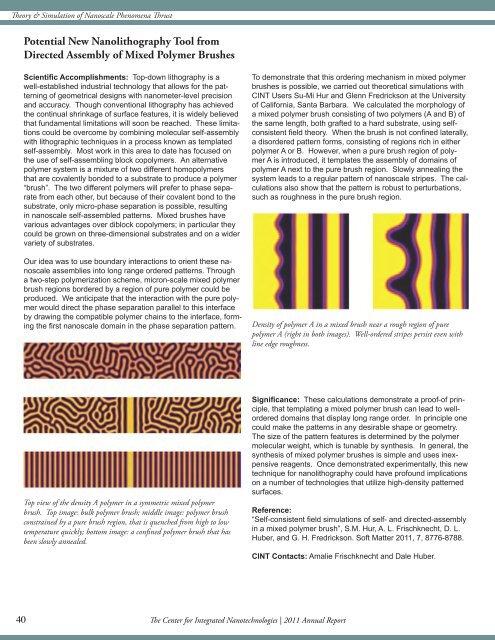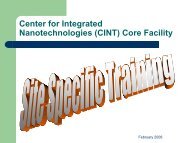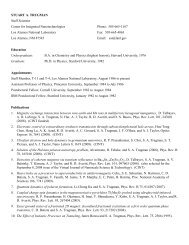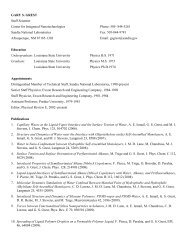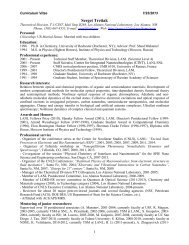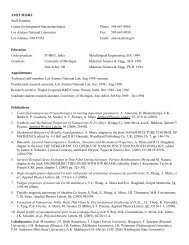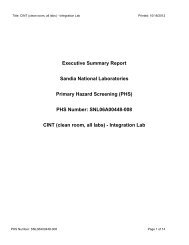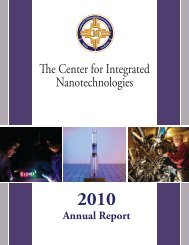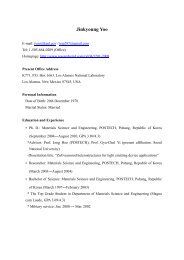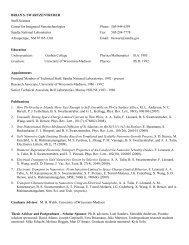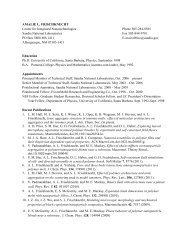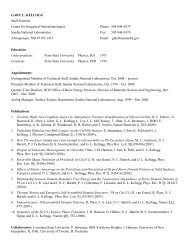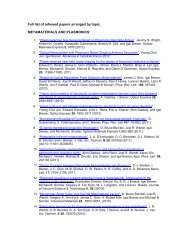2011 Annual Report - Center for Integrated Nanotechnologies - Los ...
2011 Annual Report - Center for Integrated Nanotechnologies - Los ...
2011 Annual Report - Center for Integrated Nanotechnologies - Los ...
Create successful ePaper yourself
Turn your PDF publications into a flip-book with our unique Google optimized e-Paper software.
Theory & Simulation of Nanoscale Phenomena Thrust<br />
Potential New Nanolithography Tool from<br />
Directed Assembly of Mixed Polymer Brushes<br />
Scientific Accomplishments: Top-down lithography is a<br />
well-established industrial technology that allows <strong>for</strong> the patterning<br />
of geometrical designs with nanometer-level precision<br />
and accuracy. Though conventional lithography has achieved<br />
the continual shrinkage of surface features, it is widely believed<br />
that fundamental limitations will soon be reached. These limitations<br />
could be overcome by combining molecular self-assembly<br />
with lithographic techniques in a process known as templated<br />
self-assembly. Most work in this area to date has focused on<br />
the use of self-assembling block copolymers. An alternative<br />
polymer system is a mixture of two different homopolymers<br />
that are covalently bonded to a substrate to produce a polymer<br />
“brush”. The two different polymers will prefer to phase separate<br />
from each other, but because of their covalent bond to the<br />
substrate, only micro-phase separation is possible, resulting<br />
in nanoscale self-assembled patterns. Mixed brushes have<br />
various advantages over diblock copolymers; in particular they<br />
could be grown on three-dimensional substrates and on a wider<br />
variety of substrates.<br />
Our idea was to use boundary interactions to orient these nanoscale<br />
assemblies into long range ordered patterns. Through<br />
a two-step polymerization scheme, micron-scale mixed polymer<br />
brush regions bordered by a region of pure polymer could be<br />
produced. We anticipate that the interaction with the pure polymer<br />
would direct the phase separation parallel to this interface<br />
by drawing the compatible polymer chains to the interface, <strong>for</strong>ming<br />
the first nanoscale domain in the phase separation pattern.<br />
To demonstrate that this ordering mechanism in mixed polymer<br />
brushes is possible, we carried out theoretical simulations with<br />
CINT Users Su-Mi Hur and Glenn Fredrickson at the University<br />
of Cali<strong>for</strong>nia, Santa Barbara. We calculated the morphology of<br />
a mixed polymer brush consisting of two polymers (A and B) of<br />
the same length, both grafted to a hard substrate, using selfconsistent<br />
field theory. When the brush is not confined laterally,<br />
a disordered pattern <strong>for</strong>ms, consisting of regions rich in either<br />
polymer A or B. However, when a pure brush region of polymer<br />
A is introduced, it templates the assembly of domains of<br />
polymer A next to the pure brush region. Slowly annealing the<br />
system leads to a regular pattern of nanoscale stripes. The calculations<br />
also show that the pattern is robust to perturbations,<br />
such as roughness in the pure brush region.<br />
Density of polymer A in a mixed brush near a rough region of pure<br />
polymer A (right in both images). Well-ordered stripes persist even with<br />
line edge roughness.<br />
Top view of the density A polymer in a symmetric mixed polymer<br />
brush. Top image: bulk polymer brush; middle image: polymer brush<br />
constrained by a pure brush region, that is quenched from high to low<br />
temperature quickly; bottom image: a confined polymer brush that has<br />
been slowly annealed.<br />
Significance: These calculations demonstrate a proof-of principle,<br />
that templating a mixed polymer brush can lead to wellordered<br />
domains that display long range order. In principle one<br />
could make the patterns in any desirable shape or geometry.<br />
The size of the pattern features is determined by the polymer<br />
molecular weight, which is tunable by synthesis. In general, the<br />
synthesis of mixed polymer brushes is simple and uses inexpensive<br />
reagents. Once demonstrated experimentally, this new<br />
technique <strong>for</strong> nanolithography could have profound implications<br />
on a number of technologies that utilize high-density patterned<br />
surfaces.<br />
Reference:<br />
“Self-consistent field simulations of self- and directed-assembly<br />
in a mixed polymer brush”, S.M. Hur, A. L. Frischknecht, D. L.<br />
Huber, and G. H. Fredrickson. Soft Matter <strong>2011</strong>, 7, 8776-8788.<br />
CINT Contacts: Amalie Frischknecht and Dale Huber.<br />
40<br />
40The <strong>Center</strong> <strong>for</strong> <strong>Integrated</strong> <strong>Nanotechnologies</strong> | <strong>2011</strong> <strong>Annual</strong> <strong>Report</strong>


